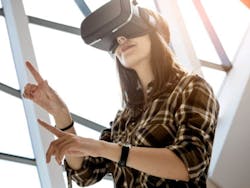UL 8400 standard to address safety for AR/VR/MR devices
UL this week announced that it will pursue a new standard, UL 8400, addressing safety for augmented, virtual and mixed reality (AR/VR/MR) devices. The announcement was made by Ibrahim Jilani, business development director, Consumer Technologies, UL, at the 2019 VR/AR Global Summit in Vancouver. At the event, Jilani highlighted areas of key concern including weight and neck strain, optical radiation, eye heat exposure and headset motion-to-photon latency.
“With the mass adoption of virtual, augmented and mixed reality equipment, balancing design and technology innovation with operational and product safety can be a challenge. UL’s goal is to keep safety in pace with innovation,” said Jilani.
As part of the UL 8400 development process, UL Standards (part of Underwriters Laboratories, the nonprofit entity within UL) is seeking equipment and component manufacturers, suppliers and others associated with the AR/VR/MR industries to participate on the standards technical panel that will draft the standard.
Once developed, UL 8400 will be one of the world’s first standards dedicated to the safety of spatial computing and extended reality equipment. The development of UL 8400 will utilize the existing technical requirements of UL 62368-1, an existing safety standard developed to mitigate risks of electrical and fire hazards in audio/video, information and communication technology equipment.
UL says the development of UL 8400 is concurrent with and in response to predicted AR/VR/MR market growth. The combination of more affordable, compact devices, advances in 5G and Wi-Fi 6 technologies and skilled software developers has made this area ripe for growth—with analysts forecasting that consumers will be using more than 100 million AR/VR/MR headsets and smart glasses by 2023, according to Gartner’s 2019 Unified Retail Retailer Survey
“With the growth in AR/VR/MR products, such as head-mounted and holographic displays and VR simulators, comes a need for consistent safety standards that provides clarity to manufacturers and addresses gaps in safety testing in the absence of a standard dedicated to the technology,” added UL's Jilani.
Those interested in providing input for the development of UL 8400 and joining its standards technical panel should contact Deborah Prince, standards program manager, Underwriters Laboratories, [email protected].
In the following video, Nelson Kunkel, managing director for Deloitte Consulting LLP, describes how VR/AR/MR is changing "how we interact with technology, objects, and even each other."
